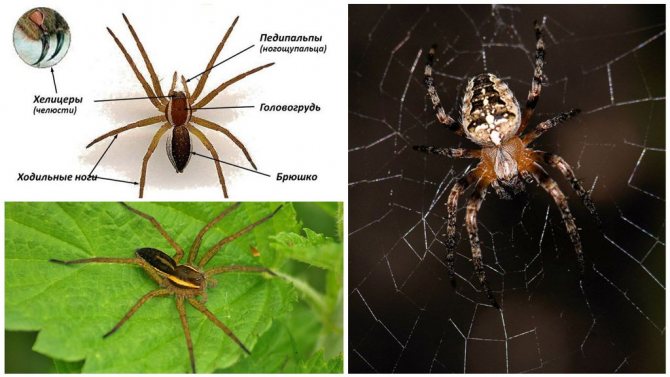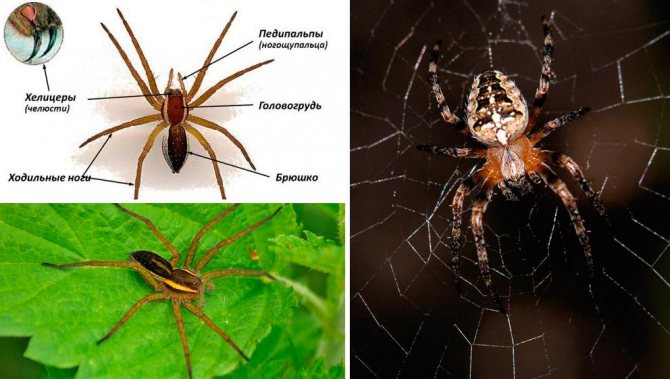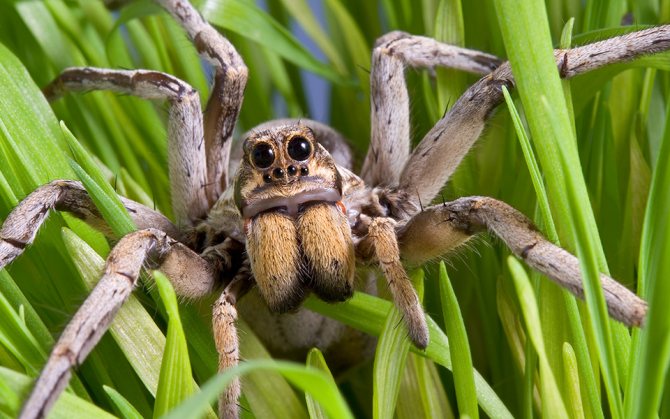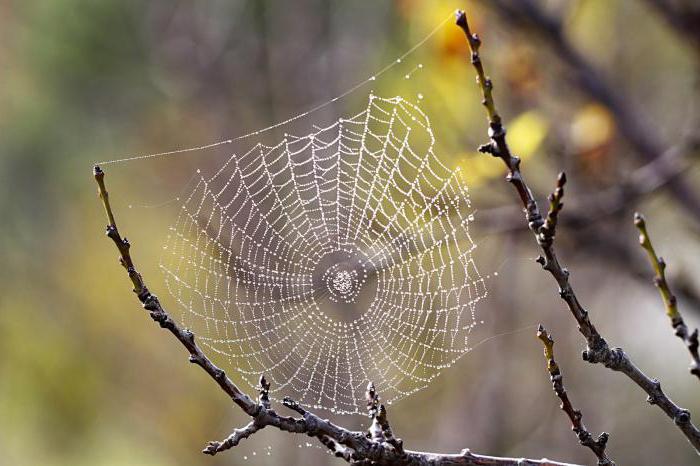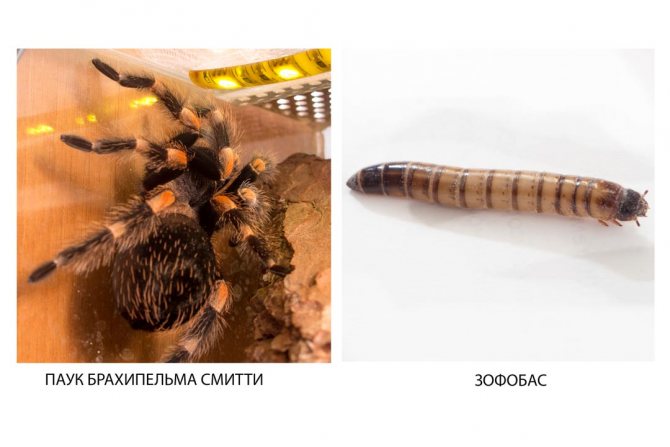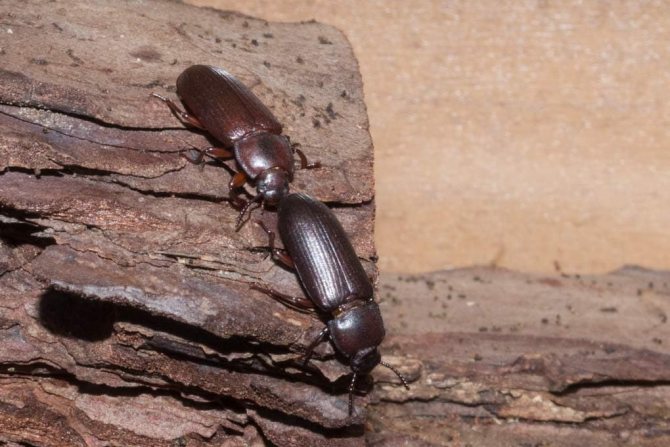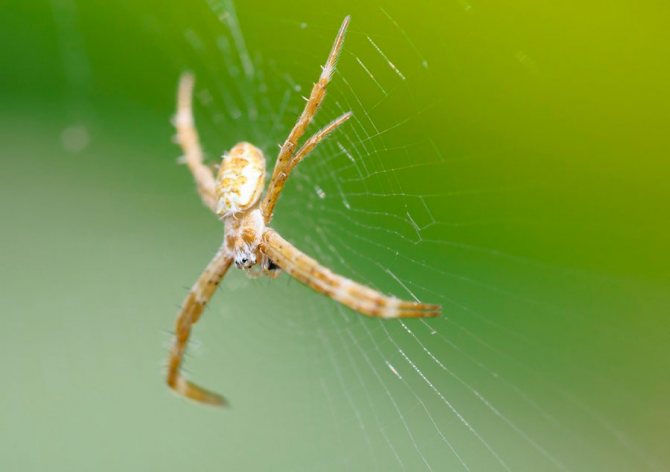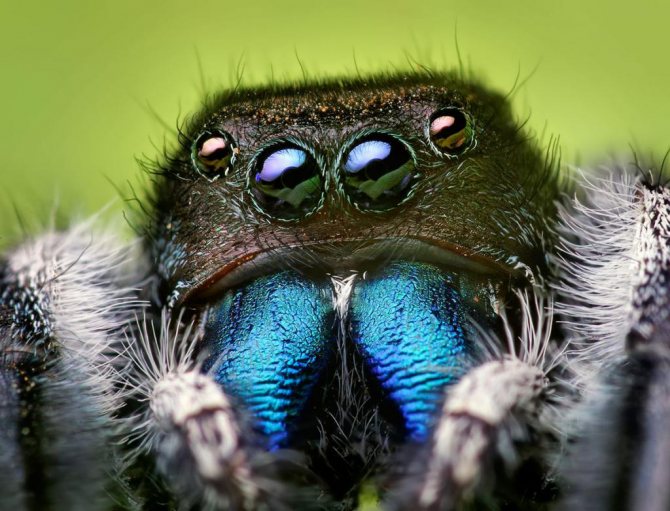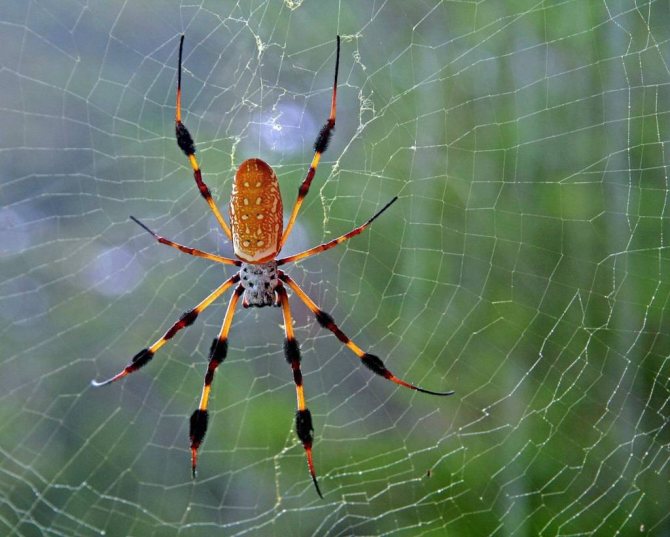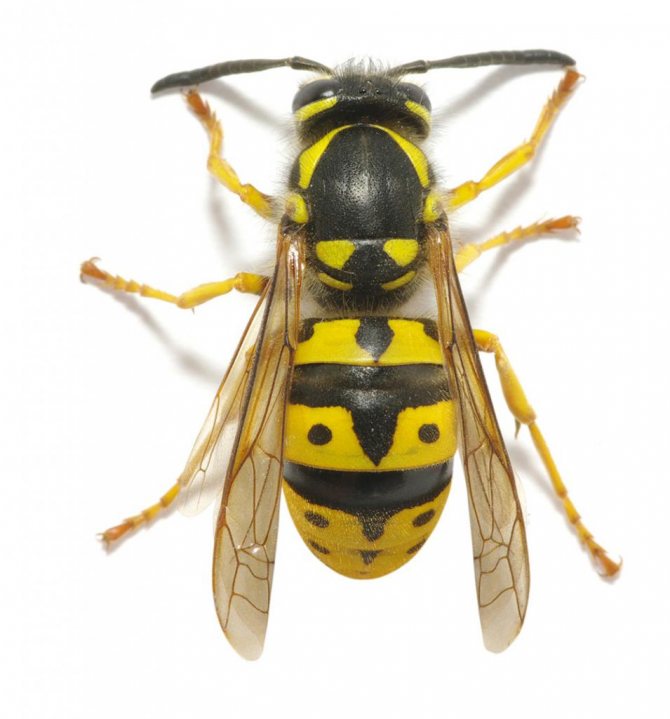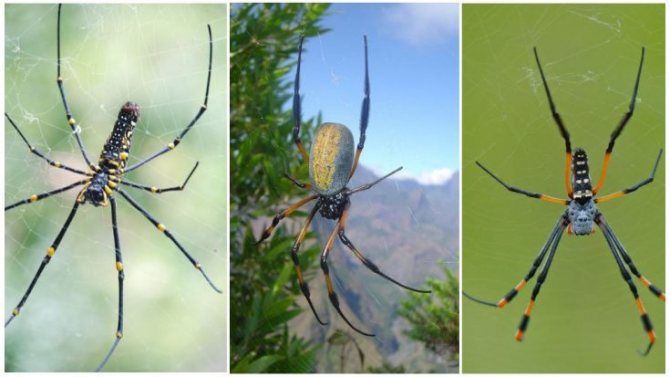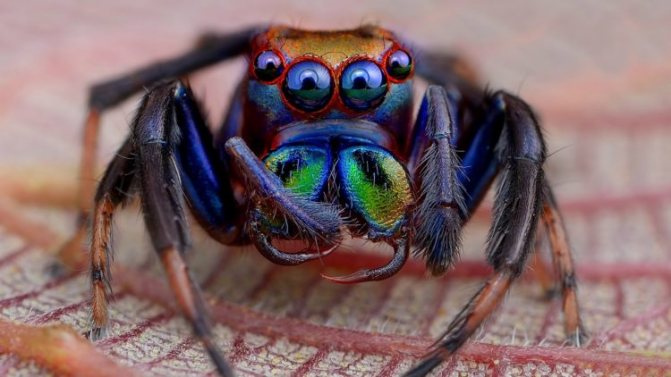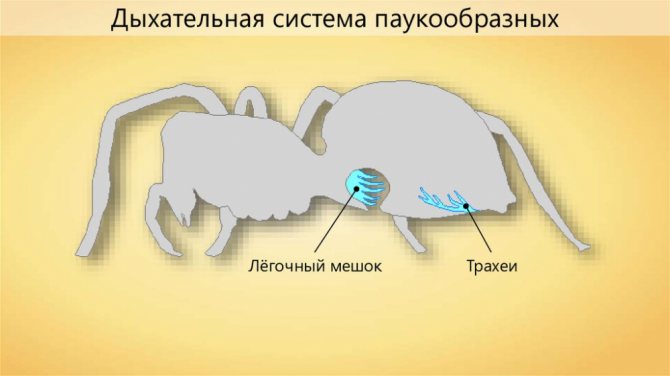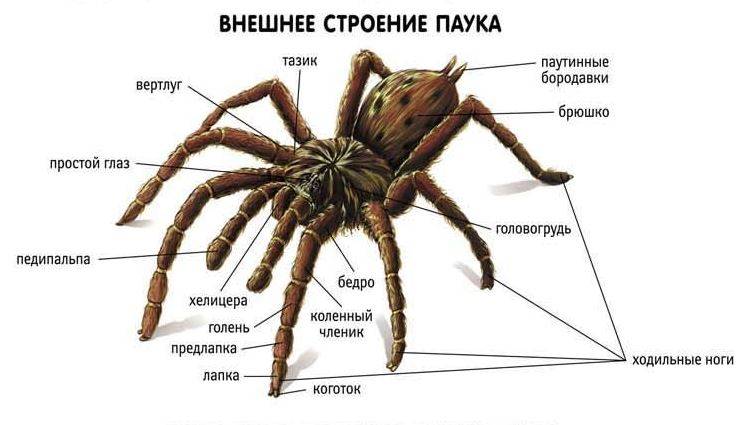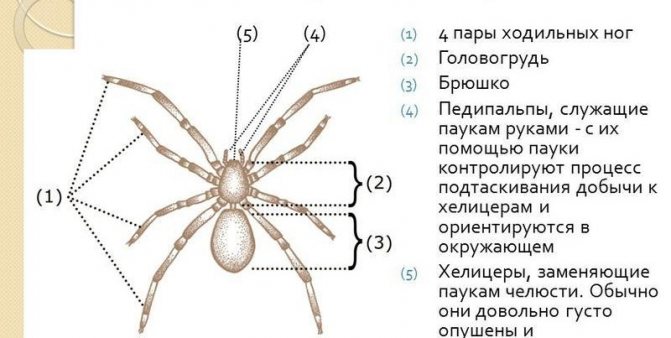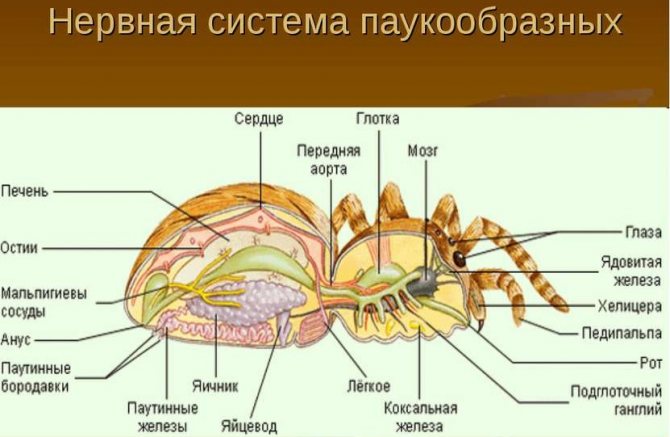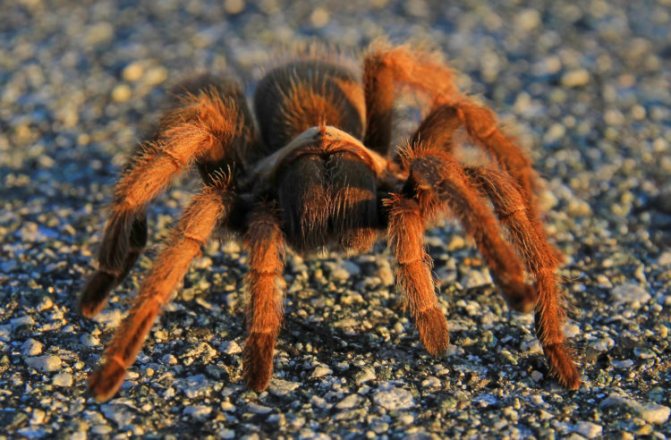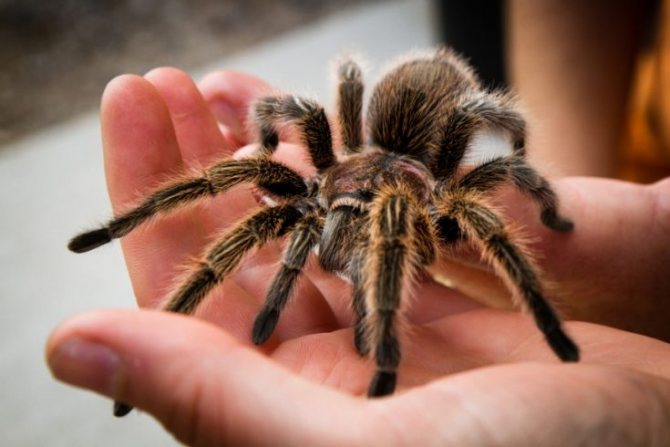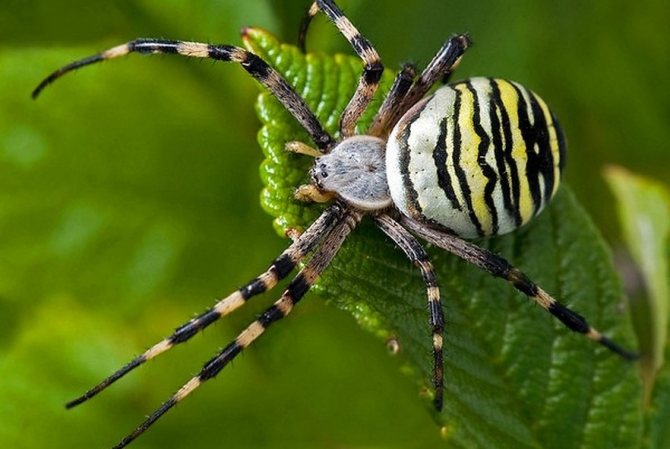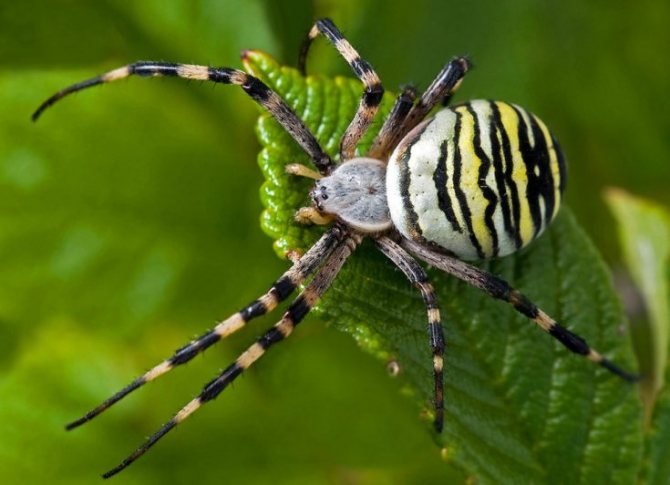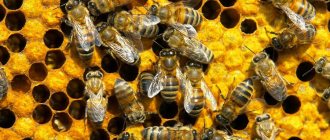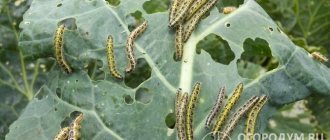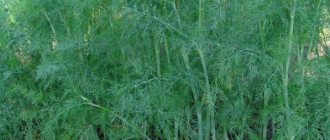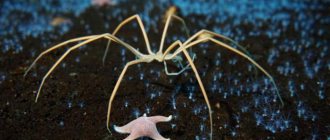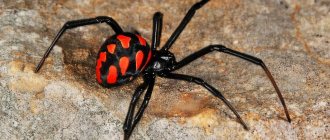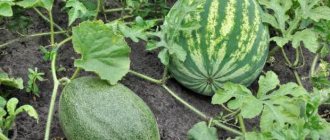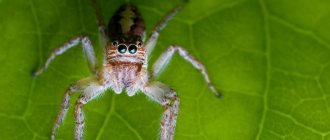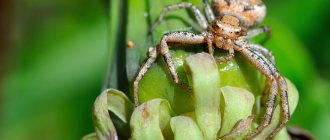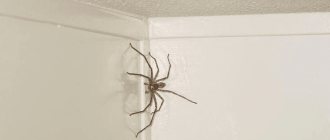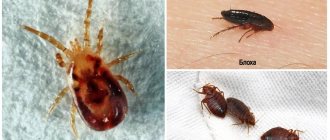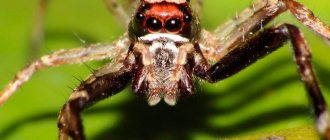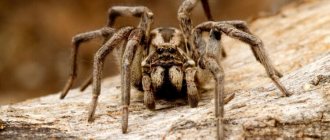The question of whether a spider is an insect or not can baffle many people who have forgotten the school curriculum or have never been interested in the flora and fauna of planet Earth. On closer examination of the detailed scientific classification, it turns out that spiders and insects have long been differentiated into different orders.
The first are the most numerous arachnids in the class of arthropods. The latter, although they belong to the class of tracheal-breathing arthropods, are attributed to a separate subtype. Insects are studied by entomology, spiders by arachnology.
Cobweb and snare construction.
The ability to secrete a spider's thread is a characteristic feature of almost all spiders. The material for it is formed in special glands located in the back of the abdomen, and the so-called. spider warts. Some spiders produce up to six different types of filaments and use each of them for very specific purposes.
Also on the topic:
MIMICRY
As the spider moves, it continually exudes cobwebs, which, like a climber, attach a safety line from time to time to the surfaces it passes over. That is why a disturbed spider can almost always, curling its legs, fall from a support and, hanging on an extensible thread, descend along it to the ground. When prey enters the net, the spider usually entwines it with a web and only then kills with poisonous claws (chelicera) and sucks it out.
Probably the most interesting feature of spiders is the construction of a web of trapping nets. Their forms are very varied and often very beautiful. Not all spiders use their webs to catch insects, but each species weaves it in a specific way, and the resulting structure may well serve as a taxonomic trait. The most beautiful, the so-called. are wheel-shaped, the snares are built by orb-web spiders from the Araneidae family. First, the spider climbs to a high place, usually near a path or other open space, and secretes a very light thread, which is picked up by the breeze and, accidentally hitting a nearby branch or other support, twists around it. The spider moves along this thread to a new point, along the way strengthening the web with an additional secreted secret. In a similar way, two or three more relatively thick "cables" are laid, making up a closed frame, inside which the trapping structure itself will be located. Usually snares are oriented more or less vertically, but some types of spiders build horizontal webs. Radius threads are pulled between the sides of the frame, connecting in the center, like spokes in a wheel hub. Now, starting near this place, the spider moves to the periphery in a spiral, leaving behind a thread attached to the radii, the distance between the turns of which is determined by the span of its limbs. While the web is not yet sticky, but upon reaching the outer frame, the spider again spirals, but with more densely located turns, returns back to the center, this time forming a thread, which, unlike the previous ones, is covered with droplets of sticky secretion. As this actually trapping spiral is laid, the thread is bitten off by the first non-sticky spiral and thrown away. Obviously, she served only as a kind of scaffolding.
When the snares are ready, the spider moves to their center or to the shelter located next to the net and waits for any flying insect to stick to the web. Usually the whole structure works one night, and by the morning it turns out to be torn in many places.
One of the most beautiful nets is woven by the usual look. Argiope aurantia
, a large spider with a black and gold pattern on its body. Its extensive spike-like snares are characterized by a zigzag thread running vertically through the center of the structure. The shape of the trapping net of other species is completely different. For example, among representatives of the genus
Frontinella
it resembles a cup on a saucer. Funnel spiders (Agelenidae family) have a net similar to a landing net, and spiders of the Gnaphosidae family build tubular shelters from their cobwebs under stones and other objects, where they hide between hunting exits. An unusual wheel-like net of golden threads builds the view
Nephila clavipes
... Common in the southern United States, this large spider has tufted legs.
The ability of spiders to secrete a silk-like thread has repeatedly led to attempts to use them like silkworms, but these experiments were not successful. The main difficulty is that you need to feed the spiders with live insects, and more than 1.3 million spiders are needed to get one kilogram of fiber quickly enough! At one time, the crosshairs of optical devices, such as theodolites, levels and telescopes, were made from cobwebs.
Many spiders do not build networks at all and simply hunt for prey from an ambush. This is common in families such as wolf spiders (Lycosidae), jumping spiders (Salticidae), and terafosid bird-eaters (Theraphosidae). Jumping spiders, for example, use their keen eyesight to track their victims and overtake them in one jump.
Possibility of keeping at home
Many people consider these arthropods to be cute, intelligent creatures, so they keep them as pets.
The container for keeping a domestic tarantula should be spacious enough, since spiders are mobile creatures. Arboreal species are more comfortable in vertical terrariums, and terrestrial ones in horizontal terrariums.
The length and width of the walls of the enclosure should be at least 80 cm for individuals larger than 8 cm and 50 cm for individuals between 2 and 7 cm.
As a substrate, it is recommended to use the mineral vermiculite or a mixture of sphagnum moss with soil in a ratio of 3: 7, respectively. Please note that any substrate must be regularly moistened.
Be sure to place branches and driftwood in the terrarium for easy placement of the tarantula and additional decoration. Use a raised piece of tree bark or a ceramic flower pot for your spider to crawl into as a burrow.
Keep the terrarium at a constant temperature and humidity. The optimum temperature for keeping a tarantula is 20 degrees. In the cold season, provide the terrarium with a thermal mat or thermal cord to warm it up.
Since these arthropods live in arid regions, the allowable humidity level for them is 35-60%. A saucer of clean water will help maintain moisture, which must be changed daily.
What to feed
The pet must be provided with food that is natural for him. Tarantulas feed on grasshoppers, cockroaches, beetles and their larvae. Large tarantulas can hunt young lizards and dragonflies.
Did you know? Tarantulas have an amazing ability to regenerate. Since these arthropods grow throughout their life and at the same time shed repeatedly, their body is renewed and regains the limbs lost in fights and during hunting. Due to the constant renewal of body cells, females of large tarantulas live from 25 to 30 years, and males from 5 to 10 years.
Feed your spider live food so it can see it and catch it. The older your pet gets, the less often it needs to be fed. Young animals must be provided with food every week, older individuals - once every one and a half weeks.
Adult three-year-old spiders should receive food no more than once every one and a half months. Keep in mind that these arthropods are voracious, and overeating can lead to rupture of the abdomen. Limit the portions you feed your spider.
Terafosides.
One of the most interesting American spiders - species Dugesiella hentzi
... This is a large animal with a leg span of up to 15 cm. The body color is dark brown, so the animal is generally unattractive, to put it mildly. It is customary to be afraid of him, but this spider is relatively harmless: its bite is no worse than a bee's. It is common in the southwestern United States and is more or less nocturnal. The main enemy of this species is a wasp from the genus
Pepsis
, the name of which is translated from English as "great blue tarantula hawk". She paralyzes the spider with a sting and drags him to her burrow to feed the larva. The bites of some tropical terafosides are very toxic, even to humans. Members of this family often live up to 20 years.
Ctenisides.
In some parts of the United States, interesting spiders from the Ctenizidae family are found. They vary in size and reach a length of 2.5 cm; the coloration of the massive body is dark. These spiders dig burrows in the ground and line their walls with cobwebs. A characteristic feature of such shelters is a tight-fitting door, which is very difficult to open when the spider is holding it from the inside. It has been established that in this case the animal can withstand a pulling force equal to almost a pound: for a person it is equivalent to 10 tons. From time to time, ctenisides come out of the burrow to hunt. Their main enemy is one of the wasp species that can open the door of their lair or attack spiders when they are outside.
How to get rid of tarantulas in the garden
Start fighting these arthropods as soon as you notice their burrows in your area. Tarantulas make deep underground passages, dig holes and thereby reduce the yield of the soil.
Walk through all the beds, check the secluded spots under the leaves and in the depressions in the soil where tarantulas could lay their eggs. Collect and burn all found cocoons. Spray the row spacings with boric acid or lime.
If there are not many tarantula minks in your area, place the baits in the form of lumps of plasticine attached to the threads like a sinker and lower them into the holes. Spiders will certainly cling to these baits, then they can be collected and destroyed.
Plant peppermint bushes in the area as a repellant plant. If possible, drive stakes into the area and put wind ratchets on them. The vibration from the rotating ratchets will be transmitted underground along the stakes, and the tarantulas will leave your area.
Important: If you plan to breed these arthropods, place the babies and the mother immediately after they reach one month of age. During this period, the female ceases to recognize her cubs and often eats a significant part of them.
Water spiders.
Relatively large spiders of the genus are common in the United States. Dolomedes
, which can run on the surface of stagnant bodies of water and even submerge under water, holding onto plants. These spiders feed on insects, fish fry and tadpoles.
In Europe, the silver spider lives, spending most of its life under water in places where there is little or no current. This is probably the most unusual spider in the world, considering that, like all representatives of its class, it breathes atmospheric air. In the spring, he goes under the water and stretches there between the plants a horizontal net of cobwebs with very small cells. Then, rising to the surface, it exposes the end of the abdomen, covered with non-wetting hairs, outward.Between them, air is collected, which the spider in the form of a bubble held by its legs drags into the depths and shakes off under its net. It does not allow the bubbles to float and, after multiple such flights, bends like a bell the size of a thimble and even more, propped up from the inside by an air chamber. The spider hides inside it, inaccessible to most enemies, immediately lays eggs, hatches juveniles and hibernates. The bells of a male and female living separately are connected to each other by a webbridge.
Insect or not
Many people think that spiders are insects, but this opinion is wrong. Animals are allocated in a separate class.
What class belong
Individuals belong to the kingdom Animals, type Arthropods, class Arachnids and the order of Spiders. Today, specialists number about 42 thousand representatives of this detachment.
In addition, scientists have identified more than 1 thousand species that do not occur in nature, but belong to fossils. More than 1000 different individuals of the Spiders order are found on the territory of Russia.
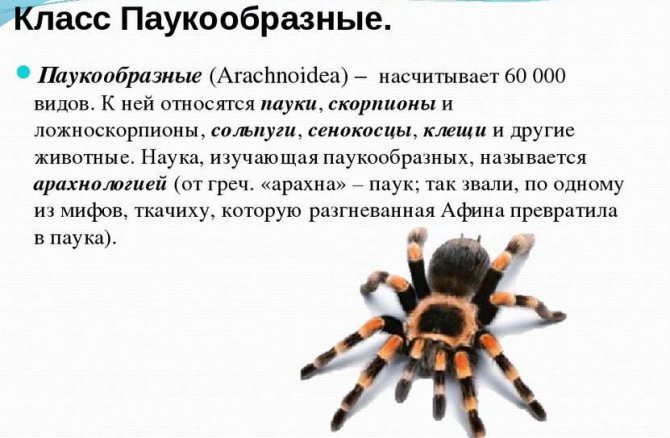
Poisonous spiders.
It is customary to be afraid of spiders. Indeed, almost all of them are armed with poisonous claws, but only a few species are dangerous to humans. In the United States, one must beware of two of them - the "brown hermit" (Loxosceles reclusa
) and "black widow" (
Latrodectus mactans
). The first is only 0.6 cm long. This spider lives in the Midwest, often in dwellings, where it hides behind furniture. A sore forms at the site of his painful bite, which may never completely overgrow. The black widow spider is found almost throughout the United States. The bite of this species causes severe pain and can lead to death due to the neurotoxin injected into the wound. The body of the female is shiny black with bright red spots. There is usually a red hourglass pattern on the underside of the abdomen. The male is much smaller than the female, but is similar in color to her. The name "black widow" is explained by the fact that the female often eats a partner after mating, which, however, is quite common among spiders. This species is not aggressive, and spiders usually try to hide from humans, but if taken in hand, they often bite.
Stories about the world of insects and spiders: for children 2nd grade
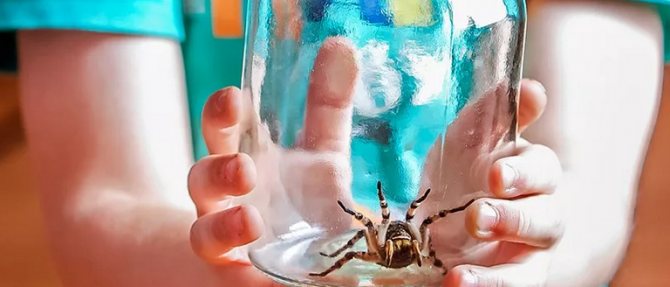

The world of insects and spiders
Children in 2-5 grade schools, independently or with the help of parents, are often asked to write stories about the world of insects and spiders. Here are two such compositions:
"Fly of butterfly"
Every summer my brother and I go to the village to see my grandmother. But if I like swimming in the lake and playing Indians more, then my brother Pasha loves to collect herbarium and insect collections. I don't really like this occupation. I believe that these are living creatures, and therefore it is inhuman to dry them on purpose.
And then one day, when my friends and I were lying in a haystack. Pasha was running around the site trying to catch some rare specimen. A butterfly landed right on my nose. She was so beautiful that it was impossible to take your eyes off. It seemed that all shades of black and blue that only exist were intricately intertwined in it.
Perhaps I would have continued to admire her if not for Pashka, who began to spin around me with his butterfly net. To be honest, he annoyed me for a long time with his love of "research". So I was sure that if he tried to catch her again, he would get a couple of slaps from me.
For a long time we rode in the hayloft - I tried to defend the right to let the butterfly free, and he - to leave it in a dried form in his collection. The scuffle turned into a rather strong fight - I managed to cut Pasha's lip, and he "knocked out" my eye.
Finally, the butterfly rose into the air, and, sparkling in the sun, disappeared into the distance.
- And you know, probably, you are right - Pasha, who has calmed down, put his hand on my shoulder - insects are born free and it is not humane to collect them.
I nodded. We stared at the pinkish sky for a long time.It was getting dark. The sounds of crickets were heard in the distance. How beautiful he is, the flight of a butterfly.
"Present"
For a long time I liked the girl from the parallel class, Katya. But how to approach it? An excellent student who even never appears in the yard. But in the end I made up my mind. However, before making the "confession", I consulted with my older brother. He said that there was no way without a gift.
“Okay, there will be a gift for her,” I thought, and carefully took out a huge spider - agriopa, placed it in a jar. The specimen was really beautiful, had a bright color of black and white stripes, which made it look like a wasp. Small hairs were visible on the chest and head.
I came to class and put the can on Katya's desk, put a note inside with a confession. I knew that such spiders were not very dangerous. Their bite can only cause irritation on the skin, which goes away after three days.
Surprisingly, my gift was not impressed. Seeing a spider on her desk, Katya first screamed, then began waving her arms, broke the can, and I had to catch my spider all over the classroom. As a result, I was kicked out of the lesson and wrote a comment. So make gifts for the girls after that.
External structure.
Spiders, unlike insects, have no antennae (antennae) and jaws. The body is covered with an external skeleton (exoskeleton) and consists of two sections - the cephalothorax, formed by the merged head and chest, and the abdomen. They are connected to each other by a narrow stem. At the front end of the cephalothorax there are simple eyes, the location of which serves as an important classification feature. Most spiders have four pairs. The cephalothorax carries six pairs of limbs. On the front of the head there are two downwardly directed chelicerae resembling jaws, each of which ends in a sharp claw. On it, the poisonous glands located in these limbs open. The second pair is pedipalps, used as palps and grasping structures. In sexually mature males, their ends are modified and used for mating. There is a small mouth opening between the bases of the pedipalps. All spiders, unlike insects, have four, not three, pairs of walking legs. The last segment of each of them bears at least two claws, and in some species there are many more.
The arachnoid glands open on the underside of the abdomen, usually with six arachnoid warts. In front of them are small airways - spiracles, or stigmas.
Description of the tarantula
There is little attraction in these, but the most noticeable feature is the three rows of glittering eyes. "Eyepieces" are always vigilant about what is happening around, distinguish between chiaroscuro and the outlines of other insects. Therefore, tarantulas are good hunters.
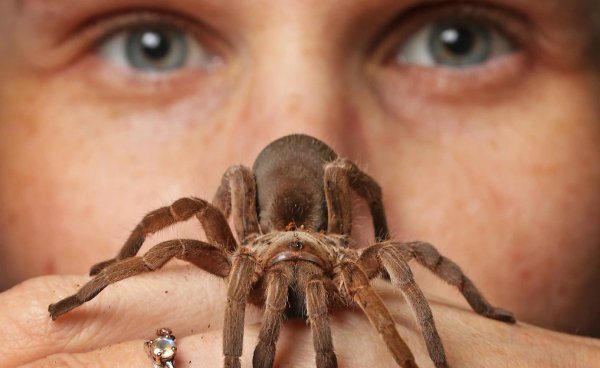

They are also helped by hearing, because they hear human steps several kilometers away.
The tarantula is a member of the wolf spider family. Their mouth appendages, chelicera, help the animal to hunt and defend itself. They adopted the direction of the jaws from the tarantula spiders.
Representatives of this genus are able to regenerate lost limbs. The torn off paws disappear, in exchange for this new ones begin to grow, increasing with each molt. Until a new one grows, the process continues.
The weight of tarantulas is small, but females can reach a mass of almost 100 g.
An adult grows to an average of 70 mm. A dull, brownish-gray male is covered with whitish hairs like down. In times of danger, he rubs his abdomen with his paws and spreads hairs around him. When inhaled, these hairs create considerable discomfort for the abuser.
Females have a pattern on the abdomen of longitudinal and several transverse stripes of black color on a reddish background. A dark shade of the cephalothorax is surrounded by a light edging.
The Apulian tarantula has good hearing. Spiders have 4 pairs of eyes.Three pairs of eyes are dark, and one, located on the sides, shines brightly in the sun, reflecting the bright rays of the sun. Thanks to such a vision system, the spider can detect prey at a distance of up to 30 cm. It distinguishes light from shadow and sees the silhouettes of victims.
An interesting feature of the Apulian tarantula is its ability to regenerate. In place of the lost limb, over time, from molt to molt, a new one grows.
The work of the muscular system is regulated by the level of hemolymph pressure. A wounded spider, losing hemolymph, becomes inactive and lethargic.
Internal structure.
Spiders feed on liquid tissues sucked from their prey, mainly insects. The digestive system of spiders consists of a specialized sucking stomach, another stomach with blind outgrowths, and an intestine surrounded by a digestive gland ("liver") and opening at the end of the body by the anus.
The circulatory system is not closed. It consists of the heart, arteries, veins and spaces (sinuses) between organs, washed by colorless blood (hemolymph). The heart is a pulsating tube with holes (ostia) that runs along the dorsal side of the body cavity. Unlike insects, it is not divided into several chambers.
Spiders, as already mentioned, breathe air. Their respiratory organs are the trachea and lungs, called pulmonary books. Each such book consists of a pouch, one of the walls of which is folded in the form of numerous leaf-like folds resembling pages. They exchange oxygen and carbon dioxide between blood and air. Outwardly, the lungs open with spiracles. The most primitive spiders have two pairs of pulmonary books; in the more advanced, one or both of them are replaced by tracheas penetrating the body.
The excretory system consists of a pair of coxal glands in the cephalothorax and the so-called. malpighian vessels in the abdomen that open into the intestines.
The nervous system is similar to that of insects. It consists of an abdominal trunk with branches and ganglia extending to different organs, collected in the cephalothorax into a large subpharyngeal node, above which there is the supraesophageal - "brain". There are sensory hairs on the pedipalps and walking legs.
The genitals are represented by the ovaries in females and the testes in males. Their holes are located below at the base of the abdomen.
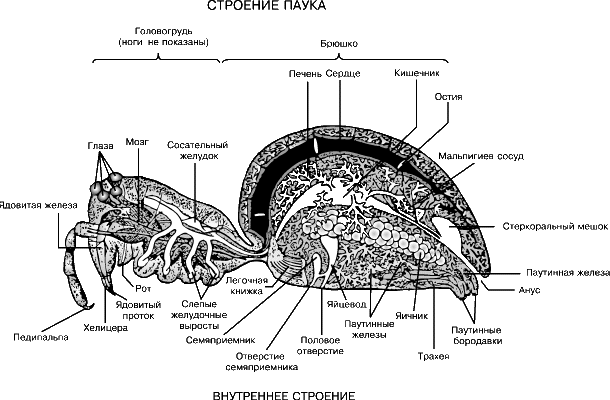

Bites
Here we will reveal the secret of whether a tarantula is dangerous to humans. There is no doubt that the spider bites painfully, in any case, the bitten ones noted that it looks like a bee sting you.
One of the most effective ways of what to do if bitten by a tarantula is to use the antidote contained directly in the body of the spider. It is enough to crush the animal and lubricate the bite site with juices, then the painful sensations will decrease, and the wound will heal faster.
We suggest that you familiarize yourself with: Chinese dog in the garden - methods of rodent control. Prairie dogs How to deal with earthen dogs
To the question of whether the tarantula is poisonous or not, we will also answer in the affirmative, otherwise how would he kill his victims. However, for a person, its poison is not dangerous, unless there is an individual intolerance or allergy to bites.
Reproduction.
Fertilization in spiders is a complex process. After mating, the female often eats the male. Eggs are laid in a spider's cocoon, which the female carries with her or attaches to a solid object, such as a plant. Some spiders, including the species mentioned above Argiope aurantia
, these cocoons are clearly visible on trees, especially in winter after the leaves have fallen. The spiders hatched from eggs soon begin to weave their own trapping nets or spread through the air, attaching themselves to flying webs.
see also
INSECTS.

